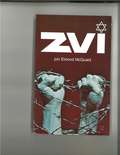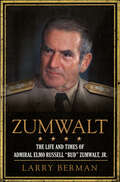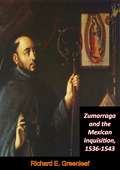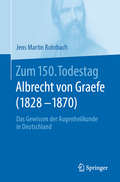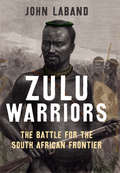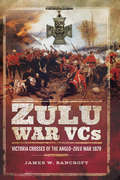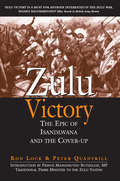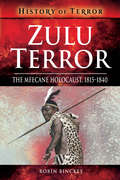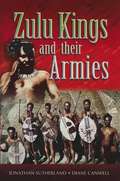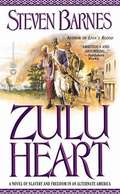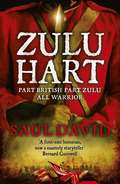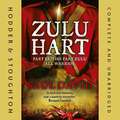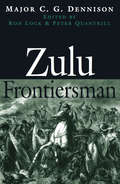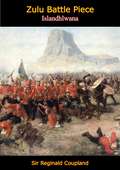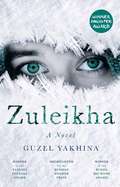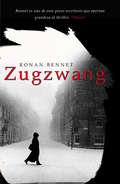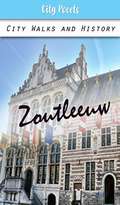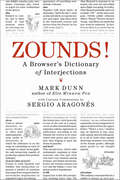- Table View
- List View
Zvi
by Elwood McquaidFor more than half a century, Zvi has endured as the best selling book produced by the ministry of The Friends of Israel. Millions of people have been touched, inspired, and encouraged by this story of a World War II waif in Warsaw, Poland. As a 10-year-old Jewish boy, Zvi was separated from his parents and forced to face the trials of survival in Adolph Hitler's crazed world. How he triumphed against all odds and found his way to Israel and faith in the Messiah is one of the great stories of our time.
Zur Geschichte des digitalen Zeitalters (Geschichte des digitalen Zeitalters)
by Ricky Wichum Daniela ZettiIn der zweiten Hälfte des 20. Jahrhunderts bearbeiteten westliche Gesellschaften Digitales in vielfältigen Gestaltungsräumen und verlagerten das digitale Zeitalter immer wieder in neue Zukünfte. Der Sammelband verfolgt technik-, sozial- und kulturhistorische Fragestellungen zur Transformation des Digitalen. Die Beiträge analysieren die mannigfaltigen Anpassungs- und Synchronisierungsprozesse zwischen digitalen Medienumbrüchen und sozialstruktureller Veränderung. Wandel wird durch Technik – mal mit ihr, mal gegen sie – gestaltet.
Zumwalt: The Life and Times of Admiral Elmo Russell "Bud" Zumwalt, Jr.
by Larry BermanAdmiral Elmo Russell Zumwalt, Jr., the charismatic chief of naval operations (CNO) and "the navy's most popular leader since WWII" (Time), was a man who embodied honor, courage, and commitment. In a career spanning forty years, he rose to the top echelon of the U.S. Navy as a commander of all navy forces in Vietnam and then as CNO from 1970 to 1974. His tenure came at a time of scandal and tumult, from the Soviets' challenge to the U.S. for naval supremacy and a duplicitous endgame in Vietnam to Watergate and an admirals' spy ring.Unlike many other senior naval officers, Zumwalt successfully enacted radical change, including the integration of the most racist branch of the military—an achievement that made him the target of bitter personal recriminations. His fight to modernize a technologically obsolete fleet pitted him against such formidable adversaries as Henry Kissinger and Hyman Rickover. Ultimately, Zumwalt created a more egalitarian navy as well as a smaller modernized fleet better prepared to cope with a changing world.But Zumwalt's professional success was marred by personal loss, including the unwitting role he played in his son's death from Agent Orange. Retiring from the service in 1974, Zumwalt spearheaded a citizen education and mobilization effort that helped thousands of Vietnam veterans secure reparations. That activism earned him the nation's highest civilian honor, the Presidential Medal of Freedom. Today Zumwalt's tombstone at the U.S. Naval Academy is inscribed with one word: "Reformer." Admiring yet evenhanded, Larry Berman's moving biography reminds us what leadership is and pays tribute to a man whose life reflected the best of America itself.
Zumarraga and the Mexican Inquisition, 1536-1543
by Richard E. GreenleafThe purpose of this study is to investigate the inquisitorial activities of Don Fray Juan de Zumárraga, first Bishop and Archbishop of Mexico, 1528-1548. Zumárraga served as Apostolic Inquisitor in the bishopric of Mexico from 1536 to 1542, when he was superseded in that office by the Visitor General, Francisco Tello de Sandoval, largely because he had relaxed Don Carlos, the cacique of Texcoco, to the secular arm for burning, an act regarded as rash by the authorities in Spain.Throughout this essay an attempt is made to relate the Inquisition to the political and intellectual life of early sixteenth-century Mexico. Zumárraga is pictured as the defender of orthodoxy and the stabilizer of the spiritual conquest in Mexico. The relationship of the individual and of society collectively with the Holy Office of the Inquisition is stressed.With the exception of background materials, this study is based entirely upon primary sources, trial records which for the most part have lain unstudied since the sixteenth century. In all, two years of research in the Ramo de la Inquisición of the Archivo General de la Nación in Mexico City were consumed in ferreting out these materials. Subsidiary investigations in other sections of the Mexican archives were made in order to place the Inquisition materials in their proper perspective.—Richard E. Greenleaf
Zum Bild des tirailleur sénégalais im französischen Comic: Repräsentation einer kolonialen Figur in der Erinnerungskultur des 1. Weltkriegs
by Jérôme SerriereDie Ausgangsfrage dieser Untersuchung ist, wie sich eine Gesellschaft an den 1. Weltkrieg erinnert und inwiefern sich diese Erinnerung mit der Zeit wandelt. Das Phänomen eines solchen „kollektiven Gedächtnisses“ und die verschiedenen Konzepte von Halbwachs, Nora („lieux de mémoire“), Jan Assmann („kulturelles Gedächtnis“) und Aleida Assmann („Funktions- und Speichergedächtnis“ des kulturellen Gedächtnisses) bilden den theoretischen Rahmen der Arbeit.Das Untersuchungsmedium zur Erforschung der französischen Erinnerungskultur zum 1. Weltkrieg bilden Comics („bande dessinées“), ein in Frankreich etabliertes und nachgefragtes Medium. Im Fokus der Betrachtung steht die Rolle der sogenannten „tirailleurs sénégalais“ in der Erinnerungskultur und wie sich die Kolonialzeit auf ihre Wahrnehmung in der französischen Gesellschaft auswirkte. Unterschieden wird dabei zwischen Tirailleurs als Kolonialsoldaten und der Figur des Tirailleurs als Konstrukt einer vergangenen Kolonialzeit. Den Kern der Arbeit bildet die Analyse zweier ausgewählter Comics. Nach festgelegten Kriterien (Deskription, Authentizität, Darstellung, Beitrag zur Erinnerungskultur) wird hier die Darstellung der Tirailleurs im Comic mit dem Bild der Tirailleurs in der Erinnerungskultur und in der Kolonialzeit verglichen. In den Comics werden aus erinnerungskulturellen Randfiguren und historischen Statisten Hauptfiguren des 1. Weltkriegs und selbstbestimmte Protagonisten postkolonialen Ausmaßes.
Zum 150. Todestag (1828-1870): Das Gewissen der Augenheilkunde in Deutschland
by Jens Martin RohrbachDas Leben Albrecht von Graefes war von großen Höhen und Tiefen geprägt, so dass es noch heute – 150 Jahre nach seinem Ableben – berührt. Neben dem frühen Tod an Tuberkulose mit 42 Jahren, dem Verlust zweier Kinder im ersten Lebensjahr und dem frühen Verlust von Mutter und insbesondere Vater stehen für ihre Zeit großartige klinische und wissenschaftliche Erfolge. Albrecht von Graefe kann daher zu Recht als Begründer der modernen Ophthalmologie und als „augenärztlicher Lehrer des Erdkreises“ angesehen werden. Er war ein großer Weltbürger, Europäer, Deutscher und Berliner. Diese Biographie ist insofern auch ein kleines Stückchen deutscher - genauer preußischer - und Berliner Zeitgeschichte. Mit der „Deutschen Ophthalmologischen Gesellschaft“ (DOG) und dem „Graefe-Archiv“ sind immer noch zwei seiner Gründungen lebendig. Genauso beeindruckend wie seine klinischen und wissenschaftlichen Leistungen war aber seine Persönlichkeit. Vor allem diese wird im vorliegenden Buch ausführlich mit Zitaten von ihm selbst, aber auch von Kollegen und Freunden beleuchtet. Das Bild, welches dadurch entsteht, ist das eines großartigen, aber eben auch zerbrechlichen Menschen, der mit seinen Wertvorstellungen zeitloses Vorbild, ja immer noch das Gewissen der Augenheilkunde in Deutschland ist.
Zulu Warriors:The Battle for the South African Frontier
by John LabandToward the end of the nineteenth century, the British embarked on a concerted series of campaigns in South Africa. Within three years they waged five wars against African states with the intent of destroying their military might and political independence and unifying southern Africa under imperial control. This is the first work to tell the story of this cluster of conflicts as a single whole and to narrate the experiences of the militarily outmatched African societies.<P> Deftly fusing the widely differing European and African perspectives on events, John Laband details the fateful decisions of individual leaders and generals and explores why many Africans chose to join the British and colonial forces. The Xhosa, Zulu, and other African military cultures are brought to vivid life, showing how varying notions of warrior honor and manliness influenced the outcomes for African fighting men and their societies.
Zulu War VCs: Victoria Crosses of the Anglo-Zulu War, 1879
by James W. BancroftThe Anglo-Zulu War lasted only six months in 1879, but in that relatively short time twenty-three men were awarded the Victoria Cross for gallantry under most trying and dangerous circumstances. Zulu warriors gave no mercy and expected none in return, yet half of the awards were given to men who went back into the midst of fierce fighting to rescue stranded comrades, well-aware that they risked suffering a particularly brutal death.Two men received posthumous awards for their efforts to save the Queens color of their regiment after the disastrous engagement against overwhelming numbers of warriors at Isandlwana, and perhaps the most famous of all awards of the Victoria Cross were the eleven gained for the immortal defence of Rorkes Drift, the battle brought back to the public consciousness by the motion picture _Zulu!_The conflict has never left the publics imagination, and continues to stir hot debate among military historians and enthusiasts.With information compiled over four decades by James W. Bancroft, a well-known and respected historian and author of several publications on the subject, this book brings together more information about the men than has ever before been collected together in one publication.
Zulu Victory: The Epic of Isandlwana and the Cover-up
by Ron Lock Peter QuantrillThe battle of Isandlwana a great Zulu victory was one of the worst defeats ever to befall a British Army. At noon on 22 January 1879, a British camp, garrisoned by over 1700 troops, was attacked and overwhelmed by 20,000 Zulu warriors. The defeat of the British, armed with the most modern weaponry of the day, caused disbelief and outrage throughout Queen Victoria's England. The obvious culprit for the blunder was Lieutenant General Lord Chelmsford, the defeated commander. Appearing to respond to the outcry, he ordered a court of inquiry. But there followed a carefully conducted cover-up in which Chelmsford found a scapegoat in the dead most notably, in Colonel Anthony Durnford. Using source material ranging from the Royal Windsor Archives to the oral history passed down to the present Zulu inhabitants of Isandlwana, this gripping history exposes the full extent of the blunders of this famous battle and the scandal that followed. It also gives full credit to the masterful tactics of the 20,000 strong Zulu force and to Ntshingwayo kaMahole, for the way in which he comprehensively out-generalled Chelmsford.This is an illuminating account of one of the most embarrassing episodes in British military history and of a spectacular Zulu victory. The authors superbly weave the excitement of the battle, the British mistakes, the brilliant Zulu tactics and the shameful cover up into an exhilarating and tragic tale.
Zulu Terror: The Mfecane Holocaust, 1815–1840 (History of Terror)
by Robin BinckesThe historian and author of The Great Trek recounts the devastating period of violence among indigenous peoples in early 19th century southern Africa. From 1815 to 1840, southeastern Africa experienced a devastating period of warfare between the Zulus, the Matabele, and other indigenous peoples. Though the causes of the unrest—which the Zulu called the Mfecane—are still debated by historians, we know that hundreds of thousands of lives lost. Some estimate the total number of deaths to be near two million. At the center of the turmoil was the Zulu Kingdom and its King Shaka, whose wars of expansion sparked mass migrations among smaller tribes. One of Shaka&’s lieutenants, Mzilikazi Khumalo, escaped execution and began a trail of destruction from Zululand north to the Highveld. Refugees from Mzilikazi&’s warpath then formed their own alliance—including with the Dutch-speaking Voortrekkers, arriving on their own &“Great Trek&” to escape British control. Finally defeated in 1836 by the Voortrekkers in a nine-day battle, Mzilikazi and his followers crossed the Limpopo River and founded the kingdom of the Matabele in what is now Zimbabwe.
Zulu Kings and their Armies
by Diane Canwell Jonathan SutherlandCovering nearly one hundred years of Zulu military history, this book focuses on the creation, maintenance, development, tactics and ultimate destruction of the Zulu army. It studies the armies, weapons and tactics under the rule of the five Zulu kings from Shaka to Dinizulu. The rule of each of the five kings is examined in terms of their relationships with the army and how they raised regiments to expand their influence in the region. All the major battles and campaigns are discussed with reference to the development of the weapons and tactics of the army.
Zulu Heart: A Novel of Slavery and Freedom in an Alternate America
by Steven BarnesSequel to Lion's Blood, in which African nations colonized the New World. Egypt and Ethiopia are locked in a vicious power struggle in the vast land of Bilalistan.
Zulu Hart: (Zulu Hart 1)
by Saul David'Gems like this are too rare. I was hooked in ten pages.' Conn IgguldenGEORGE HART just wants to serve his Queen and honour his family. It's not that simple.BASTARDHe doesn't know his father, only that he's a pillar of the Establishment. His beloved mother is half Irish, half Zulu.ZULU In a Victorian society rife with racism and prejudice, George's dark skin spells trouble to his regimental commander.WARRIORBut George has soldiering in his blood - the only question is what he's really fighting for: ancestry or Empire. In the heat of battle he must decide . . .
Zulu Hart: (Zulu Hart 1)
by Saul David Saul David Ltd'Gems like this are too rare. I was hooked in ten pages.' Conn IgguldenGEORGE HART just wants to serve his Queen and honour his family. It's not that simple.BASTARDHe doesn't know his father, only that he's a pillar of the Establishment. His beloved mother is half Irish, half Zulu.ZULU In a Victorian society rife with racism and prejudice, George's dark skin spells trouble to his regimental commander.WARRIORBut George has soldiering in his blood - the only question is what he's really fighting for: ancestry or Empire. In the heat of battle he must decide . . .
Zulu Hart: (Zulu Hart 1)
by Saul David Saul David LtdGEORGE HART just wants to serve his Queen and honour his family. It's not that simple.BASTARDHe doesn't know his father, only that he's a pillar of the Establishment. His beloved mother is half Irish, half Zulu.ZULU In a Victorian society rife with racism and prejudice, George's dark skin spells trouble to his regimental commander.WARRIORBut George has soldiering in his blood - the only question is what he's really fighting for: ancestry or Empire. In the heat of battle he must decide . . .(P)2009 ISIS Publishing Ltd
Zulu Frontiersman
by Major C. G. DennisonIt was said of George Dennison that he had seen more active service in southern Africa than any other living man. An eminent soldier cast from a colonial mould of bitter experience, rather than of a formal military education, he was also a frontiersman equal in standing to any legendary figure of the American West. His military career saw him rise from an uncouth trooper with the Bloemfontein Rangers to, fifty years later, a distinguished officer whose advice was sought by the likes of Lord Kitchener, Sir Garnet Wolseley and other British military names of fame. During this time Dennison encountered many foes, some he would have known as neighbours, or men who had lately been his comrades-in-arms. He fought against Afrikaners, Dutchmen, Voortrekkers and the Boers. His black foes were also diverse; the stealthy Xhosa of the eastern Cape; the battle-axe wielding Basutos from their lofty kingdom in the clouds; the Transvaal baPedi, the masters of fortification, and most impressive of all, the amaZulu warriors of King Cetshwayo. In Zulu Frontiersman, Dennison recounts his remarkable exploits in rich and lively prose. Originally published in 1904 in abridged form (under the title A Fight to the Finish) his memoirs have now been expertly reworked by Ron Lock and Peter Quantrill in order to reinstate some of the fascinating details missing from the earlier published account, including for example Dennison's involvement in and dramatic escape from the battle of Hlobane.
Zulu Battle Piece: Islandhlwana
by Sir Reginald CouplandFirst published in 1948, renowned British Empire historian Coupland describes, with swift and vivid strokes, the situation between whites and blacks, the great military qualities and terrifying military tactics of the Zulu warriors and the characters of the Englishmen, soldiers and politicians, involved in the disaster. Having prepared the reader with consummate art and scholarship, he then sets the great action in that strange, eerie land, until the reader can truly feel that he has lived through it himself. The aftermath brings him to Rorke’s Drift and the gallant British stand that averted irretrievable disaster.A first-rate account of the battle.
Zuleikha: A Novel
by Guzel YakhinaWINNER OF THE BIG BOOK AWARD, THE LEO TOLSTOY YASNAYA POLYANA AWARD AND THE BEST PROSE WORK OF THE YEAR AWARD A sweeping, multi-award winning novel set in the aftermath of the Russian Revolution, as gangs of marauding soldiers terrorise and plunder the countryside. Zuleikha, the 'pitiful hen', is living in the home of her brutal husband and despotic mother-in-law in a small Tatar village. When her husband is executed by communist soldiers for hiding grain, she is arrested and sent into exile in Siberia. In the first gruelling winter, hundreds die of hunger, cold and exhaustion. Yet forced to survive in that harsh, desolate wilderness, she begins to build a new life for herself and discovers an inner strength she never knew she had. Exile is the making of Zuleikha.
Zukunft und Wissenschaft
by Reinhold PoppWissenschaftlich fundierte Zukunftsforschung findet insbesondere im deutschsprachigen Raum nur vereinzelt statt. In Deutschland, Österreich und der Schweiz gibt es insgesamt nur drei Hochschulen mit Professuren für Zukunftsforschung - dem steht jedoch eine wachsende Zahl von Unternehmensberatern und Trend-Gurus gegenüber, die sich selbst als Zukunftsforscher bezeichnen. Die Autoren des Sammelbands beschäftigen sich in ihren Beiträgen systematisch mit den bislang vernachlässigten wissenschaftlichen Grundlagen der Zukunftsforschung.
Zugzwang
by Ronan BennettZugwang: [del alemán Zug («movimiento») y Zwang («exigencia, obligación»)]. En ajedrez se emplea para describir una posición en que uno de los jugadores queda reducido a un estado de total impotencia: está obligado a mover, pero cualquier movimiento solo empeora su situación.San Petersburgo, 1914. El periodista O.V. Gulko es brutalmente asesinado al pie del puente Politseiski. Entonces, el psiquiatra Otto Spethmann recibe la visita de la policía. Un revolucionario relacionado con la muerte del periodista ha aparecido muerto, y entre sus ropas se ha hallado la tarjeta del doctor. De pronto, Otto Spethmann se ve implicado en un complot para asesinar al zar en el que están implicados miembros de su círculo más cercano. Desde ese momento, Spethmann estará en posición de Zugzwang.Una hermosa estudiante envuelta en actividades políticas radicales, una gran dama con un pasado doloroso y un presente sensual, un complejo detective de policía, un portentoso ajedrecista del shtetl, el líder de los bolcheviques, un siniestro plutócrata de derechas, agentes secretos y mafiosos bolcheviques compartirán el tablero.«Zugzwang es un thriller de primera, con reminiscencias de la potencia narrativa de Joseph Conrad y la inteligencia de género de Graham Greene.»San Francisco Chronicle
Zoya: An epic, unputdownable read from the worldwide bestseller
by Danielle SteelTHE WORLD'S FAVOURITE STORYTELLERNEARLY ONE BILLION COPIES SOLD One woman's odyssey through a century of turmoil . . . St Petersburg: one famous night of violence in the October Revolution ends the lavish life of the Romanov court forever - shattering the dreams of young Countess Zoya Ossupov.Paris: under the shadow of the Great War, émigrés struggle for survival as taxi drivers, seamstresses and ballet dancers. Zoya flees there in poverty - and leaves in glory.America: a glittering world of flappers, fast cars and furs in the Roaring Twenties; a world of comfort and café society that would come crashing down without warning. An epic and romantic tale from one of the best-loved writers of all time. Perfect for fans of Penny Vincenzi, Lucinda Riley and Maeve BinchyPRAISE FOR DANIELLE STEEL:'Emotional and gripping . . . I was left in no doubt as to the reasons behind Steel's multi-million sales around the world' DAILY MAIL'Danielle Steel is undeniably an expert' NEW YORK TIMES
Zoya (Bestseller Oro Ser. #Vol. 245)
by Danielle SteelLa historia de una mujer singular que fue testigo y actor de los acontecimientos que sacudieron al mundo durante el siglo XX Tras la devastación de la Revolución rusa y la Primera Guerra Mundial, Zoya, la joven prima del zar, se ve obligada a huir de San Petersburgo y buscar refugio en París. Las adversidades que allí le sobrevienen terminan de convencerla de que su mundo ha cambiado para siempre. Logra unirse al ballet ruso de París, con cuyo salario mantiene a su indómita abuela y a sí misma. El amor le ofrece una tregua de felicidad cuando el apuesto capitán Clayton Andrews, cautivado por la joven aristócrata, se la lleva a Manhattan como su prometida. Sin embargo, ninguno de los dos imaginaba las penurias que deberán soportar durante los años de la Gran Depresión que asolan Norteamérica. A través de la historia de un siglo convulsionado y cambiante, Zoya representa una de esas mujeres luchadoras cuyo legado quedarápor siempre entre nosotros. La crítica ha dicho...«Genuinamente conmovedora.»People
Zoya
by Danielle SteelSu mundo ha cambiado para siempre, y tras pasar por terribles momentos, logra unirse al ballet ruso en París, con cuyo salario mantiene a su indómita abuela y a sí misma. El amor aparece de nuevo cuando conoce al capitán Clayton Andrews, quien, cautivado por la joven aristócrata, se la lleva a Manhattan como su prometida. Sin embargo, ninguno de los dos imagina las penurias que deberán soportar durante los años de depresión que asolan Norteamérica. A través de la historia de un siglo convulsionado y cambiante, Zoya representa una de esas mujeres singulares cuyo legado quedará por siempre entre nosotros.
Zoutleeuw: Guida turistica della città e percorsi pedonali
by Kathleen ReindersLa città di Zoutleeuw ha un numero considerevole di edifici protetti e di paesaggi da sogno. Il centro città conserva ancora la sua strada medievale intorno al Kleine Gete, ma verso la fine del XIXesimo secolo si è esteso verso sud, il cosiddetto Stationswijk, con alcune belle ville. La maggior parte dei monumenti si trova nel centro città.
Zounds!: A Browser's Dictionary of Interjections
by Mark Dunn Sergio AragonésFrom Geronimo! to gesundheit to haminahamina to holy mackerel, and from abracadabra to zoinks—a look at interjections like you’ve never seen them before.Often thought of as unnecessary verbal fringe or simply linguistic decoration, interjections (ahem, howdy, mamma mia, pshaw, tally-ho, whoop-de-do) may well be the most overlooked part of speech in the English language. ZOUNDS! A Browser's Dictionary of Interjections focuses the spotlight on this most deserving (and sometimes most demented) grammatical group. A light-hearted look at more than 500 interjections, ZOUNDS! explores the origins of these essential words and highlights the contributions of these previously unheralded parts of speech.Perfect for both word lovers and the casual reader, ZOUNDS! brings together the linguistic talents of Mark Dunn, author of the award-winning novel Ella Minnow Pea, and the graphic hilarity of Sergio Aragonés, the legendary cartoonist and contributor to Mad Magazine, for a delightful romp through grammar, culture, and the English language.Famous interjections include:“Eureka!” —Archimedes“Badabing-badaboom!” —Tony Soprano“Stuff and nonsense!” —Alice, Alice in Wonderland“Bah! Humbug!” —Scrooge“Fiddle-dee-dee !” —Scarlett O'Hara“Leapin' lizards!” —Little Orphan Annie“Nanoo, nano” —Mork, from “Mork & Mindy”“Dyn-O-Mite!” —Jimmie Walker, “Good Times”“Bully!” —President Theodore Roosevelt
